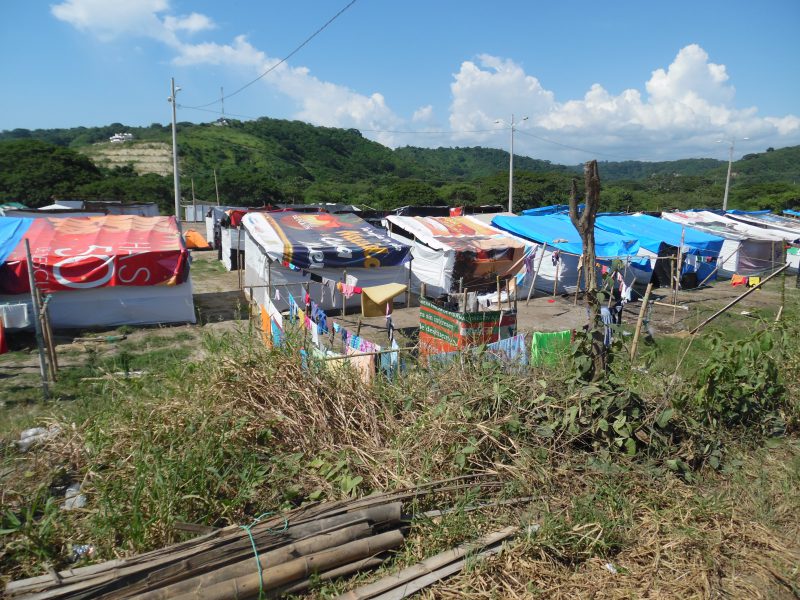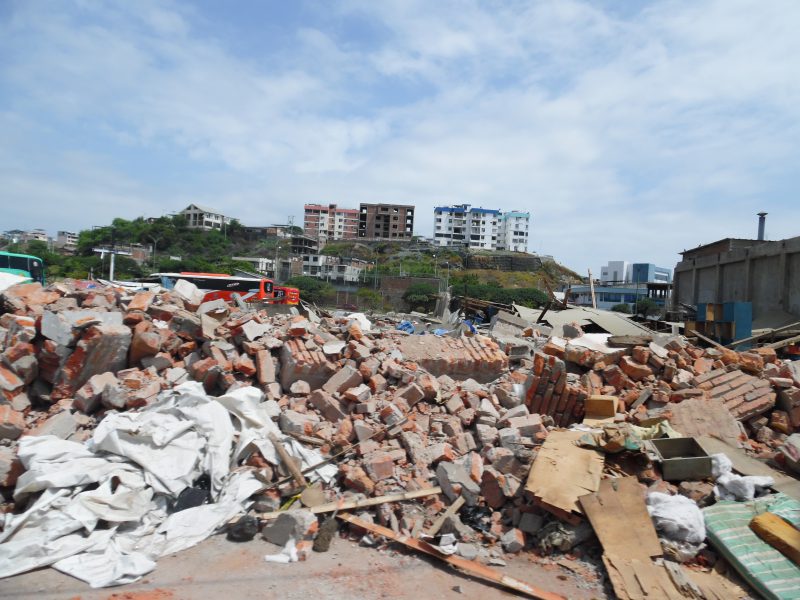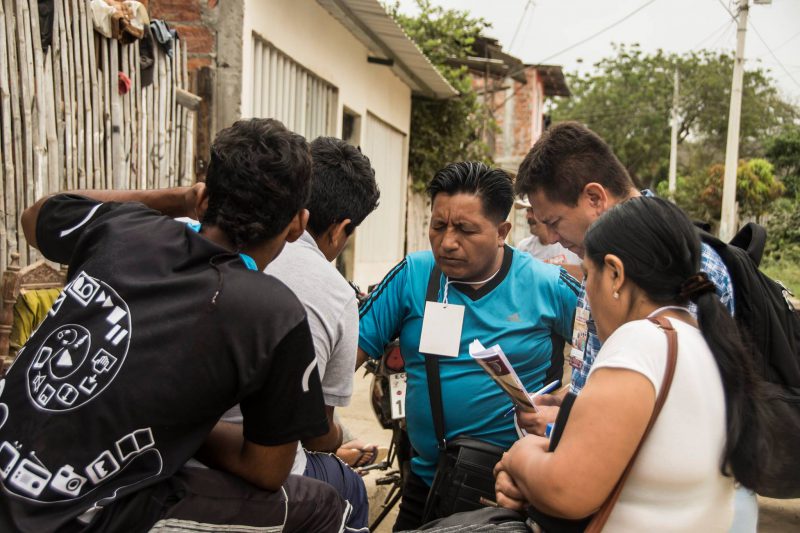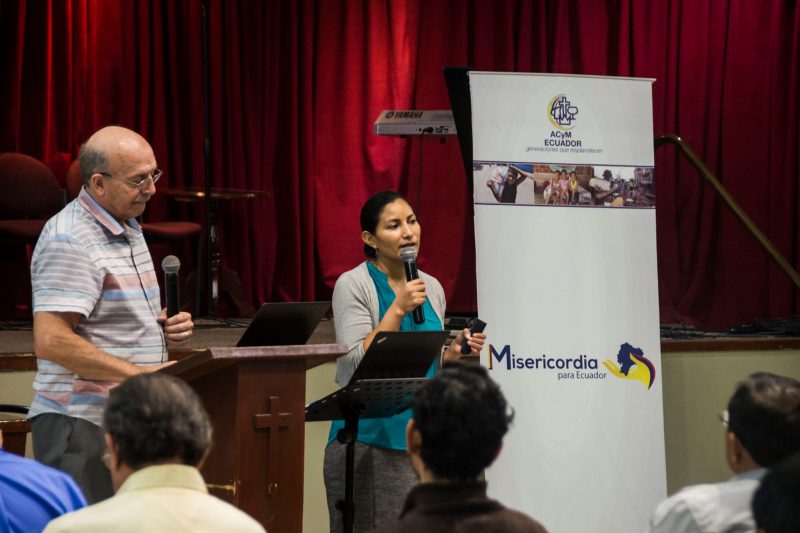Today’s post is written by Mike Sohm, president of CAMA, and Sara Barzola, the project coordinator of “Mercy for Ecuador.” This article was originally published in the March/April 2017 issue of Alliance Life Magazine.
Men, women, and children living on the west coast of Ecuador will never forget where they were April 16, 2016, at 6:58 p.m.
That is when a massive 7.8-magnitude earthquake shook the ground beneath them. At least 673 people died, and more than 16,600 suffered injuries, per Wikipedia.
“We went under the table, and I began to pray, asking the Lord that His protection, His hand, would be over us,” says Assistant Pastor Sergio Plaza of Jesus, the Rock Alliance Church in Bahía de Caráquez.
Others recall hearing glass break, watching the lights go off and on, and feeling as though they were about to die.
“I was on the second floor, and it began to sink. I sank with it, with the upper floor not too far above me,” says María Aendaño from Portoviejo. “I heard how my daughter was screaming. She was saying, ‘My legs!’ And we communicated. The only thing I told her was to pray.”

Early accounts after the quake reported that one Alliance church had been completely destroyed, and 12 others were damaged.
Under the leadership of Rev. David Muthre, president of The Evangelical Christian and Missionary Alliance of Ecuador, C&MA churches from across the country began a ministry called “Mercy for Ecuador.” Congregants gave more than $100,000 to rehabilitate the churches damaged in the earthquake.
The mission of “Mercy for Ecuador,” which continues today, is fourfold:
- Serve children at risk
- Provide spiritual support for pastors in the earthquake zone
- Stimulate the local economy
- Increase the national church’s capacity to respond to disasters
1. Children at Risk
In the wake of a disaster in an impoverished area, children are vulnerable to being trafficked. Whether suddenly orphaned and/or homeless, they become easy targets.
For Ecuadorian churches already heavily involved in kids’ ministry, the earthquake revealed the impact disasters have on young people. Before April 16, Central Alliance Church of Bahía de Caráquez ministered weekly to 450 children. Due to lives lost and homes destroyed in the earthquake, that number fell to 80 children.
Following the disaster, church leaders worked with the local police to secure the children’s safety. The Ecuadorian C&MA also contacted the United Nations Office of Coordination of Humanitarian Affairs (UNOCHA) to inquire about the welfare of children and to gain information to plot its own future ministry to them.

As part of the “Mercy for Ecuador” initiative, the Ecuadorian C&MA decided to allocate significant funds for ministry to at-risk children in partnership with Compassion International, a child-advocacy ministry.
2. Spiritual Support
“In 42 seconds of terror, the earthquake decimated the town of Pedernales,” says Gary Fairchild, former director of Global Disaster Response for CAMA.
“Homes completely crumbled, and elite hotels cracked from top to bottom. People dependent upon the hospitality industry—the backbone of the local economy—lost their entire livelihood in an instant.”
When the earthquake struck this town of nearly 22,000, people dazed, stunned, and worried made their way to the city square, calling out the names of loved ones who were missing. This continued throughout the night and into the next day.
Pastor Carlos Zambrano from Pedernales Alliance Church followed the crowd to the square to comfort the distraught, including one young man whose entire family had died. Unable to cope with such great loss, the boy committed suicide a few days later.
Pastors throughout the Manabí Province experienced similar situations over many months. They were exhausted from providing long hours of pastoral care. They also felt torn between meeting the needs of their own families and those of their congregations. Pastors needed rest and renewal so they would not experience burn out.

With funding from CAMA, a retreat was held in July 2016 for pastors, their wives, and children. Other Ecuadorian pastors, including Rev. David Muthre, came to preach God’s Word. There were also times of prayer, rest, community, and laughter.
The pastors and families shared testimonies of their experiences on the night of April 16. Then they gathered together to pray and thank God for life as well as to pray for protection and peace over Ecuador and for the strength to continue in God’s work.
3. Local Economy
Initially, “Mercy for Ecuador” planned to send volunteers from large city churches not affected by the earthquake to help rebuild the damaged churches. But when members of the church in Bahía de Caráquez considered that the earthquake left many in their city unemployed, they decided to hire local construction workers.
A large church provided financial support for the project. Thus, Central Alliance Church of Bahía de Caráquez was the first Christian community in the town to rebuild its facilities.
“Because of the church’s efforts to include the local community in the church rehabilitation, 20 new families have joined the fellowship since the earthquake,” Pastor Ramón Veléz says.
In July 2016, this same church hosted a missions conference for Ecuadorian church leaders. Hundreds of people from all over the country came to the event and stayed in local hotels, ate in local restaurants, and shopped at local businesses. The event profoundly and positively influenced Bahía de Caráquez’s economy during a difficult time.
Now 12 large city churches have adopted the 12 Alliance churches needing repairs. For example, Ficoa Alliance Church in Ambato is supporting the reconstruction of Jesus, the Rock Alliance Church. North Alliance Church in Guayaquil is joining with other congregations to rebuild a church in Junín.
4. Disaster Response
Ecuadorian communities located in earthquake zones will experience future quakes. So for the first time in Ecuador, CAMA held disaster response and disaster risk reduction training in July 2016. Gary Fairchild led day-long sessions in four churches in four cities: Quito, Ambato, Guayaquil, and Bahía de Caráquez.

“The local churches of Ecuador now recognize their value in a new way,” Gary says. “They have embarked on a new era of ministry: disaster preparation for their congregations and disaster risk reduction in their communities.”
Churches have a crucial role in helping to build community resilience for the next earthquake—the goal of disaster risk reduction. As local churches prepare their congregations for the next disaster, they also must work with their communities to mitigate the effects of a future disaster.
“This is the moment for us to be the church,” Pastor Paúl Candela says. “Like the Early Church, people can see us and say, ‘Look how they love each other.’ [We’re] a church that supports widows, a church that provides for orphans, and a church always looking out for the most vulnerable.”
God, who is rich in mercy, is working through His Church to make His name known in Ecuador. To Him be all the glory!